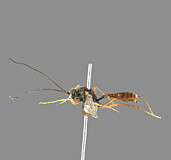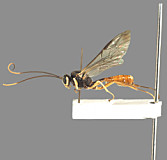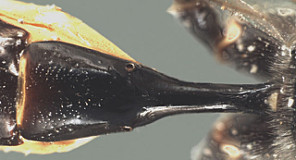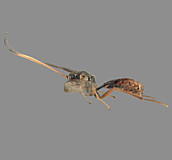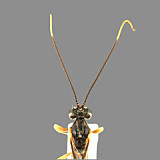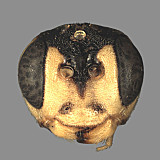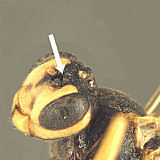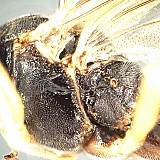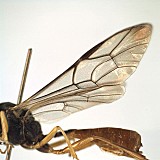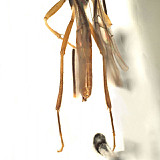Pergaphaga xanthops Wharton, 2010
The underlying sculpture of the female paratype is not as finely granular or shagreened as it is in the holotype. This is especially noticeable on the malar space, lower gena and area extending between the eye and ocellar field.
The species name is in reference to the extensively yellow face of the females.
The epicnemial carina is also weaker in P. xanthops than in the other three species of Pergaphaga, and the dorsal extent is particularly difficult to discern. The clypeus appears somewhat different in shape in Fig 3. when compared to the figures of the other three species shown on their respective species pages. This is almost entirely due to the angle of view, with the face angled more ventrally in Fig. 3.
Pergaphaga iangauldi, P. leaski Wharton, and P. xanthops form a well-supported clade relative to P. nigra, characterized by reduced body sculpture (e. g. Fig. 5), reduced fore wing areolet (e. g. Fig. 6), and the pattern of pale coloration on the face, legs, and metasoma (Figs 3, 4, 6, 7).
Type material: Holotype. Female (ANIC), with labels as follows: “Canberra ACT/ 11 Apr 1958/ E F Riek” “Pergaphaga/ det. I.D. Gauld, 198” “HOLOTYPE / Pergaphaga/ xanthops/ Wharton” [red, handwritten]
Paratypes: 1 female, same data as holotype except 15.iv.1958 (BMNH); 1 male, New South Wales, Dainers Gap, 36.12S, 148.43E, 1585 m, 6.iii.1974, P Morrow, Eucalyptus pauciflora, stellulata, and perriniana forest, Ex Eucalyptus pauciflora (ANIC).
This work would not have been possible without the groundwork provided by Ian Gauld’s study of the Australian fauna, including the initial recognition of the Pergaphaga xanthops as an undescribed species. We are particularly grateful for his assistance in many aspects of this study. We also thank the following curators and researchers for extended loans of the material used for this revision: John LaSalle (ANIC), Ian Gauld (deceased) and Gavin Broad (BMNH), Ken Walker (MVMA), and Chris Burwell (QMBA). We thank David Wahl of the American Entomological Institute (AEIC) for permission to use material previously published in the Contributions of the American Entomological Institute, as well as for useful feedback throughout our study of Westwoodiini. Matt Yoder provided considerable assistance with databasing issues, and our use of PURLs (http://purl.oclc.org) in this regard follows the example of their use in publications by Norm Johnson. Heather Cummins also graciously assisted us with image processing, formatting, and literature retrieval. This revision was conducted at Texas A&M University and is based upon work supported by the National Science Foundation’s PEET program under Grant No. DEB 0328922 and associated REU supplement nos DEB 0723663 and DEB 0522836. Page last updated April, 2011.
This material is based upon work supported by the National Science Foundation under Grant Number DEB 0328922 with REU supplement DEB 0723663 and 0522836.
Any opinions, findings, and conclusions or recommendations expressed in this material are those of the author(s) and do not necessarily reflect the views of the National Science Foundation.
